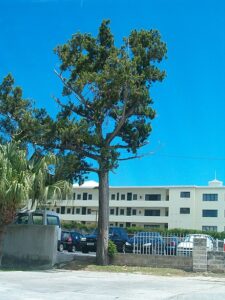The Bermuda cedar tree (Juniperus bermudiana) is an iconic symbol of Bermuda. This endemic conifer has played a significant role in the island’s history, culture, and ecosystem. This article delves into the characteristics, ecological importance, historical significance, and conservation efforts surrounding this remarkable tree species.

Characteristics of the Bermuda Cedar Tree
The Bermuda cedar is a medium-sized, evergreen conifer, reaching heights of 15-20 meters (50-65 feet) and sporting a pyramid-shaped crown. The tree’s leaves are scale-like and dark green, while its small berries mature to a bluish-black hue. Adapted to Bermuda’s subtropical climate, the cedar thrives in various soil types, from sandy coastal areas to rocky outcrops.
Ecological Importance
As a keystone species in Bermuda’s ecosystem, the cedar tree provides essential habitats and nesting sites for a variety of native bird species. Additionally, these trees contribute to soil integrity maintenance and erosion prevention, especially along coastlines and on rocky terrain.
Historical Significance
Bermuda cedar trees have been an invaluable resource for the island’s inhabitants throughout history. The wood was highly prized for its durability, resistance to termites and rot, and natural aromatic qualities. Consequently, it was extensively used in construction, shipbuilding, and furniture making.
The overexploitation and deforestation of Bermuda cedar trees led to a significant decline in their population. In the mid-20th century, a devastating scale insect outbreak, introduced accidentally, further decimated the cedar population, pushing the species to the brink of extinction.
Conservation and Restoration Efforts
Recognising the Bermuda cedar’s importance to the island’s ecosystem and heritage, several conservation and restoration programs have been initiated. These efforts include reforestation projects, protection measures, and public awareness campaigns to educate both locals and visitors about the cedar’s significance.
Conclusion
The Bermuda cedar tree is a symbol of the island’s unique flora and cultural heritage. Although the species has faced numerous challenges in the past, conservation and restoration efforts are underway to ensure the tree’s survival and continued role in Bermuda’s ecosystem. As a reminder of the island’s natural beauty and resilience, the Bermuda cedar remains an emblematic feature of this subtropical paradise.
Residents can purchase a Bermuda Cedar for the holidays instead of a Christmas tree from the Bermuda National Trust.


